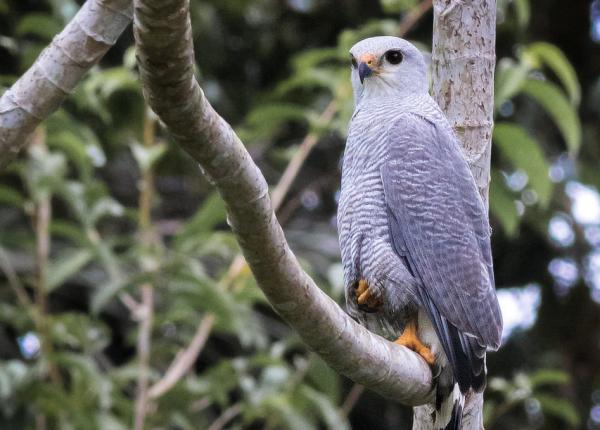Did You Know?
- There are three subspecies of the Gray-lined Hawk
- This hawk may be expanding its range in some areas, particularly where forest is being replaced by second-growth
- This species was split from the Gray Hawk
How The Peregrine Fund is Helping
Though The Peregrine Fund does not work directly with Gray-lined Hawks, our efforts in scientific research, habitat conservation, education, and community development help conserve raptors around the world. We also supply literature to researchers from our avian research library, which helps scientists the world over gather and share important information on raptor conservation.
Where They Live
This hawk is found throughout much of the Americas from southern Costa Rica south through Central America, and into parts of South America, as well as Trinidad and Tobago.
It makes its home in a wide variety of lowland to mid-elevation habitats including broken forest, forest edges, riverine and gallery forests, savannas and pastures with trees.
What They Do
The appropriately named Gray-lined Hawk has grey lines across its upper breast and belly. It is a beautiful, light grey color all over. Its tail is black with two wide, white bands. Its feet and cere are bright yellow. Juvenile Grey-lined Hawks look very different from the adults. Young birds are brown with some whitish mottling across the back and wings. Their breasts are cream-colored and decorated with brown splotches.
If you find yourself in this hawk's territory, look for it perching on power poles, or on an exposed tree in more open areas. Don't forget to search the sky, as well, as it often soars at relatively low heights. The good news is that this species is often very vocal, emitting a high-pitched call or several piping notes to alert you to its presence.
Why They Need our Help
The Gray-lined Hawk is classified as a species of Least Concern by the IUCN. It is a widespread species and relatively common throughout its range. However, this doesn't mean it doesn't face many threats. Perhaps the biggest threat to this species is loss of habitat due to deforestation.
What They Eat
This medium-sized buteo feeds on a diverse array of prey. Using its strong legs and talons it traps and kills snakes, lizards, frogs, small mammals, including rabbits, squirrels, and mice. It hunts birds like quails and young doves, will feed on fishes, and insects such as beetles.
The Grey-lined Hawk often takes a "wait and watch" approach to hunting. It might perch on a branch in the canopy, waiting for prey to pass by. When it does, the hawk ambushes its quarry by dropping on it in a downward glide. It can also pursue its prey it in active flight.
Nests, Eggs, and Young
Grey-lined Hawks build their nests of sticks and twigs. Once the platform nest is constructed, they will line it with fresh green leaves. They have been known to nest in evergreen trees and sometimes in dead trees.
The female will usually lay two eggs per breeding season, but researchers have seen nests with as little as one egg and as many as four! The eggs are white or bluish-white, and sometimes they are decorated with some reddish-brown markings. After the nestlings hatch, they will remain in the nest for about 42 days before they are ready to fly for the first time.
The adult pair is not shy about defending its territory and protecting its young. If other raptors pass through the area, the hawks will chase them off!
Gray-lined Hawk and the World Center for Birds of Prey
A visit to the World Center for Birds of Prey is a great way to learn about raptors. From interactive exhibits, tours, and presentations, there is a little something for everyone. Additionally, we have an amazing group of Avian Ambassadors - including a Swainson's Hawk and a Harris' Hawk - that provide visitors with an opportunity to see some fascinating raptors up close. Our staff is on hand year-round to answer any questions you may have about Gray-lined Hawks or any other bird of prey.
References:
Bierregaard, R. O., P. F. D. Boesman, and J. S. Marks (2020). Gray-lined Hawk (Buteo nitidus), version 1.0. In Birds of the World (J. del Hoyo, A. Elliott, J. Sargatal, D. A. Christie, and E. de Juana, Editors). Cornell Lab of Ornithology, Ithaca, NY, USA. https://doi.org/10.2173/bow.gryhaw3.01
BirdLife International. 2020. Buteo nitidus. The IUCN Red List of Threatened Species 2020: e.T22727766A168803943. https://dx.doi.org/10.2305/IUCN.UK.2020-3.RLTS.T22727766A168803943.en. Downloaded on 12 August 2021.
Global Raptor Information Network. 2021. Species account: Gray-lined Hawk Buteo nitidus. Downloaded from http://www.globalraptors.org on 11 Aug. 2021









